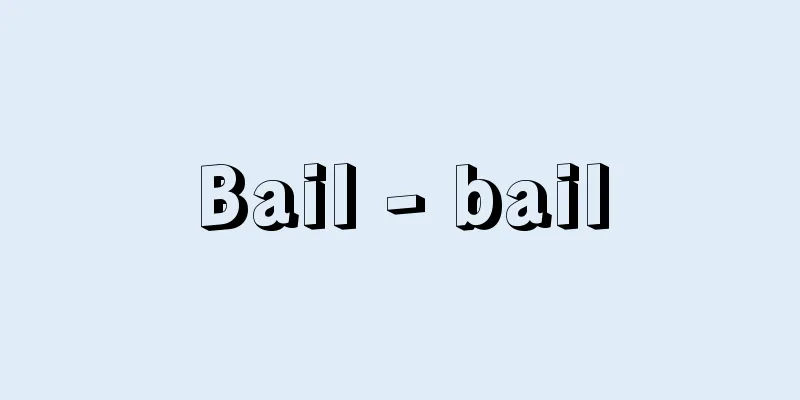Bail - bail

|
It refers to the court suspending the execution of the detention of a defendant after a surety bond is paid (Criminal Procedure Law, Article 88 and following). There is no bail system for suspects (Criminal Procedure Law, Article 207, Paragraph 1). A detained defendant or his/her lawyer, legal representative, guardian, spouse, lineal relative, or sibling may request bail (Criminal Procedure Law, Article 88). When a request for bail is made, it must be granted (mandatory bail) except in the following cases: That is, the defendant: (1) has committed a crime punishable by death or life imprisonment or imprisonment for a minimum term of one year or more; (2) has previously been convicted of a crime punishable by death or life imprisonment or imprisonment for a maximum term of more than 10 years; (3) has habitually committed a crime punishable by imprisonment or imprisonment for a maximum term of three years or more; (4) there is sufficient reason to suspect that the defendant will destroy evidence; (5) there is sufficient reason to suspect that the defendant will harm the person or property of the victim or other person deemed to have knowledge necessary for the trial of the case or their relatives, or will commit an act that intimidates such persons; or (6) the name or address of the defendant is unknown (Article 89 of the same Act). In addition to the above-mentioned bail upon request, there is a system of bail by ex officio. In other words, the court may grant bail by ex officio when it deems appropriate, taking into consideration the degree of risk that the defendant will flee or destroy evidence if released on bail, as well as the degree of disadvantage to the defendant in terms of health, economy, social life, or preparation for defense due to continued physical detention, and other circumstances (Article 90 of the same law). The matters to be considered by the court were stipulated in the 2016 amendment to the Code of Criminal Procedure, but it is said that this stipulation clarifies the interpretation of discretionary bail that was already established in practice, and does not change the previous operation. In addition, when detention by detention becomes unreasonably long, the court must cancel the detention by decision or grant bail at the request of the person who has the right to bail or by ex officio (Article 91, paragraph 1 of the same law). When granting bail, the amount of the guarantee must be determined. The amount of the bail must be a reasonable amount that is sufficient to guarantee the defendant's appearance, taking into consideration the nature and circumstances of the crime, the probative value of the evidence, and the character and assets of the defendant. In addition, when granting bail, the court may restrict the defendant's residence and impose other conditions that it deems appropriate (Article 93 of the same law). A decision granting bail cannot be executed until the deposit has been paid (Article 94, Paragraph 1 of the same law). In cases where a defendant fails to appear without a valid reason after receiving a summons, which constitutes a reason for revoking bail, the bail may be revoked by decision and the deposit may be confiscated (in practice, this is called "bottori" to distinguish it from confiscation) (Article 96, Paragraphs 1 and 2 of the same law). If a person who has been granted bail fails to appear without a valid reason after receiving a sentence and the sentence has been finalized, or if he or she flees, the court must confiscate all or part of the deposit by decision at the request of the prosecutor (Article 96, Paragraph 3 of the same law). When a sentence of imprisonment without work or a heavier sentence has been pronounced, bail becomes void (Article 343 of the same law). In addition, after a sentence of imprisonment without work or a heavier sentence has been pronounced, the provisions of mandatory bail (Article 89 of the same law) do not apply (Article 344 of the same law). As of 2016, the number of people whose cases had been finalized (first instance) in district courts was 53,247, of which 11,654 were released on bail, for a detention rate (total number of people in custody / total number of people whose cases had been finalized) of 76.0% and a bail rate (number of people released on bail / total number of people in custody) of 28.8%. In summary courts, the number of people whose cases had been finalized was 5,856, of which 629 were released on bail, for a detention rate of 73.1% and a bail rate of 14.7% (2017 White Paper on Crime). [Ichiro Uchida and Morikazu Taguchi, April 18, 2018] [Reference] |Source: Shogakukan Encyclopedia Nipponica About Encyclopedia Nipponica Information | Legend |
|
保証金を納付させて、裁判所が被告人の勾留(こうりゅう)の執行を停止することをいう(刑事訴訟法88条以下)。被疑者に対する保釈制度はない(同法207条1項)。勾留されている被告人またはその弁護人、法定代理人、保佐人、配偶者、直系の親族もしくは兄弟姉妹は、保釈の請求をすることができる(同法88条)。保釈の請求があったときは、次の場合を除いては、これを許さなければならない(必要的保釈)。すなわち、被告人が、(1)死刑または無期もしくは短期1年以上の懲役もしくは禁錮にあたる罪を犯した者であるとき、(2)前に死刑または無期もしくは長期10年を超える懲役もしくは禁錮にあたる罪につき有罪の宣告を受けたことがあるとき、(3)常習として長期3年以上の懲役または禁錮にあたる罪を犯した者であるとき、(4)罪証を隠滅すると疑うに足りる相当な理由があるとき、(5)被害者その他事件の審判に必要な知識を有すると認められる者もしくはその親族の身体もしくは財産に害を加えまたはこれらの者を畏怖(いふ)させる行為をすると疑うに足りる相当な理由があるとき、(6)被告人の氏名または住居がわからないとき(同法89条)、である。 以上の請求による権利保釈のほかに、職権による保釈の制度がある。すなわち、裁判所は、保釈された場合に被告人が逃亡しまたは罪証を隠滅するおそれの程度のほか、身体の拘束の継続により被告人が受ける健康上、経済上、社会生活上または防御の準備上の不利益の程度その他の事情を考慮し、適当と認めるときは、職権で保釈を許すことができる(同法90条)。この裁判所の考慮事項は、2016年(平成28)の刑事訴訟法改正で明記されたものであるが、実務上すでに確立していた裁量保釈の解釈を明記したものであって、それまでの運用を変更するものではないとされている。また、勾留による拘禁が不当に長くなったときは、裁判所は保釈請求権者の請求により、または職権で、決定をもって勾留を取り消し、または保釈を許さなければならない(同法91条1項)。保釈を許す場合には、保証金額を定めなければならない。保証金額は、犯罪の性質および情状、証拠の証明力ならびに被告人の性格および資産を考慮して、被告人の出頭を保証するに足りる相当な金額でなければならない。また保釈を許す場合には、被告人の住居を制限し、その他適当と認める条件を付することができる(同法93条)。保釈を許す決定は、保証金の納付があった後でなければ、これを執行することができない(同法94条1項)。召喚を受けて正当な理由なく被告人が出頭しないなど保釈取消し事由にあたる場合には、決定をもって保釈は取り消され、保証金は没取(没収と区別するために実務上「ぼっとり」と読んでいる)されることがある(同法96条1項・2項)。保釈された者が、刑の言渡しを受けその判決が確定したのち、執行のため呼出しを受け正当な理由がなく出頭しないとき、または逃亡したときは、検察官の請求により、決定で保証金の全部または一部を没取しなければならない(同法96条3項)。禁錮以上の刑に処する判決の宣告があったときは、保釈はその効力を失う(同法343条)。また禁錮以上の刑に処する判決の宣告があったのちは、必要的保釈(同法89条)の規定は、これを適用しない(同法344条)。 2016年の時点で、地方裁判所において終局(第一審)した人員は5万3247人、うち保釈人員は1万1654人で、勾留率(勾留総人員÷終局総人員)76.0%、保釈率(保釈人員÷勾留総人員)28.8%となっている。また、簡易裁判所では終局総人員5856人、うち保釈人員は629人で、勾留率73.1%、保釈率14.7%である(2017年版『犯罪白書』)。 [内田一郎・田口守一 2018年4月18日] [参照項目] |出典 小学館 日本大百科全書(ニッポニカ)日本大百科全書(ニッポニカ)について 情報 | 凡例 |
>>: Khoja (English spelling) khwāja [Persian]
Recommend
Seven Cauldrons - Nanatsugama
A basaltic sea cave (Ten) located at Tokizaki, Yak...
thitsiol
...The drying of urushi involves polymerization d...
Oligarchy and oligarchy
…He can be considered the intellectual pioneer of...
Carbocation
An ion of an organic compound that has a positive ...
Large-leaved oyster mushroom - Ootogariamigasatake
...It is distributed throughout Japan, and is com...
Beefeater
...Prisoners executed or imprisoned here include ...
A selection of ancient styles
A two-volume book on waka poetry from the early Ka...
matrona
…However, while there were chaste women who could...
Self-power generation - Jikahatsuden
It refers to the generation and transformation of...
Tobetsu [town] - Tobetsu
A town in Ishikari District, Hokkaido. The souther...
quantitative analysis
…Chemical analysis is the process of clarifying w...
Romances sans paroles (English spelling) Romances ansparoles
…In 1870, he married Mathilde Mautet, who was sun...
Samehada (Shark Skin)
A slang term for a particular dry, coarse conditio...
Onishi [town] - Onishi
This is an old town in Tano County, occupying the ...
Sasaguri [town] - Sasaguri
A town in Kasuya County in central Fukuoka Prefect...









